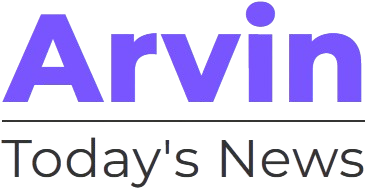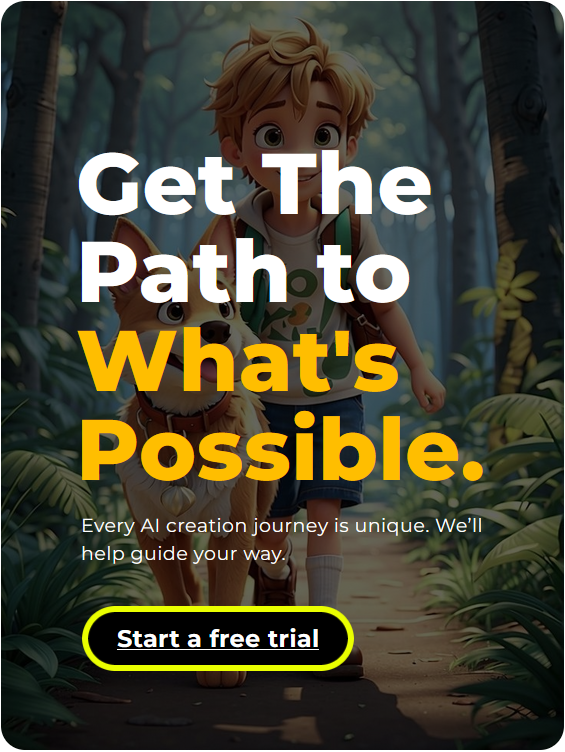A statement of intent is a formal document in which an individual presents goals, motivations, and qualifications for pursuing a particular opportunity. It is an arena where aspirations can be made and aligned with the requirement of the target organization or program. Smart writing tools like Arvin AI ensure that crafting a meaningful personalized statement is faster and easily accessible with intelligent support when writing. This piece reveals the nature of the statement of intent examples, discusses what there is to know in doing it right, and the actionable tips to develop one.
Part 1: What is a Statement of Intent?
A statement of intent, also referred to as a personal statement or motivation letter, is a formal document stating your intention for applying for a specific opportunity. It gives an overview of your goals, background, and aspirations and, at the same time, indicates your awareness of the organization or program.
Purpose
The most important reason for a statement of intent examples is to:
- Determine your interest and motivation in the opportunity.
- Present your qualifications, experiences, and achievements.
- Explain how your skills relate to the mission of the organization or program.
A good statement of intent examples fills the gap between eligibility and suitability by giving a glimpse into your personality and vision.
Key Elements
A well-structured statement of intent examples usually contains:
- Introduction: Introduce yourself briefly and state why you are applying.
- Reasons for Interest: Explain why you are interested in the particular domain or opportunity.
- Relevant Achievements: Highlight accomplishments that demonstrate your readiness for the role.
- Future Aspirations: Articulate your long-term goals and how the opportunity aligns with them.
Importance in Different Contexts
College or University Admissions
Admissions committees use statements of intent to assess your fit for their academic programs and your potential contributions.
Job Applications
Employers view them as a reflection of your professional aspirations and alignment with the company’s values.
Research Grants or Fellowships
For grants, a statement of intent examples reflects research goals, methodology, and how funding will affect a field.
Creative Projects or Startups
Creative entrepreneurs or professionals use these statements in pitching ideas, demonstrating both vision and passion.
Part 2: Best Practices for Writing a Statement of Intent Examples
Research First
Before writing, thoroughly research the organization or program to understand its mission, values, and objectives. Tailor your statement to demonstrate how your goals align with theirs.
Be Specific
Generic statements dilute impact. Instead of vague claims like “I’m passionate about science,” include concrete examples, such as your role in a successful research project or a significant breakthrough.
Structure Your Statement
Divide your statement into clear sections:
- Introduction: This opens with a compelling reason for your application.
- Body: Elaboration of your motivations, relevant experiences, and achievements
- Conclusion: This ends with a statement showing your future goals, through which the opportunity would guide you to achieve these objectives.
Focus on Authenticity
Your statement ought to reflect your genuine aspirations as well as personality. The writing should not be full of exaggeration. Emphasize experiences as well as goals that one considers true to them.
Use Compelling Language
- Clarify and be precise
- Avoid any technical jargon that will make readers confused.
- Use potent words with excitement and commitment.
Editing & Proofreading
Refine your statement by:
- Reviewing it for grammar and typographical errors
- Getting feedback from a mentor or peers
- Revising several drafts for flow and coherence
Part 3: Examples of Statement of Intent across Fields
A Statement of Intent is a personal declaration describing your goals, motivations, and qualifications tailored to a given field or purpose. From academic programmes, business opportunity, creative skill and grant this document remain a roadmap to your dream. Further below, we focus on various fields and offer you examples of how you can structure a statement of intent examples properly.
Academic Applications
Academic Statements of Intent demonstrate intellectual passions, academic achievements, and future career aspirations. You should have consolidated in these statements your capacity to tailor the chosen program while demonstrating recognition of strength from the institution. Most of these claims cover both or individual and career goals and missions are coupled with the adequate experiences.
Example 1: Statement for Applying to a Graduate Program in Psychology
“I am interested in exploring human behavior complexity and the aspects of mental health. Having graduated with a Bachelor’s in Psychology and research experience with CBT, I wish to explore your graduate program in Clinical Psychology to take my expertise further. I honed my ability to design appropriate intervention plans while doing my internship at [organization]. The focus on evidence-based practices in your graduate program is in alignment with my goal of working to support adolescents who have to deal with mental health problems. I believe your mentorship and resources will equip me to make a positive difference as a licensed clinical psychologist.”
Example 2: Statement for a Research-Focused STEM Program
“Driven by an insatiable curiosity for renewable energy solutions, I aspire to contribute to sustainable energy systems through your research-focused program. My undergraduate thesis on photovoltaic technology and internship at [company] strengthened my technical skills in developing efficient energy storage solutions. I share your faculty’s passion for solar technology research to achieve my goal of promoting the growth of clean energy technologies. I believe that due to the fact that your program cuts across many disciplines, I stand to benefit in my quest to address some of the compelling energy issues around the globe.”
Business Applications
For business purposes, Statements of Intent are useful in asserting your strategic vision, as well as leadership abilities. They demonstrate skills you can offer to an organization or create when starting a business prompt. Such statements are frequently, DIR reinforcing statements, announcing tangible objectives and valuable contributions.
Example 1: Statement of Intent for a Leadership Role in a Company
“As an experienced marketing strategist with a proven track record of driving growth, I want to lead your organization’s marketing division toward unprecedented success. I have developed data-driven campaigns that increased brand visibility and revenue by 35%. My expertise lies in fostering cross-functional collaboration to achieve strategic objectives. I look forward to joining your leadership team and implementing innovative strategies that resonate with global audiences, ensuring sustained business growth and competitive advantage.”
Example 2: Statement for Launching a New Startup
“My vision is to establish a sustainable e-commerce platform that bridges the gap between local artisans and global consumers. This would help empower communities through fair trade and also was sustainable practices. With a background in business management and successful execution of pilot projects in [industry], I am committed to transforming the way local crafts are perceived and valued. I am optimistic that applying an entrepreneurial spirit shall establish the ground that apart from fueling economic growth shall foster cultural exchange across the world.”
Creative Fields
A statement of intent examples in creative areas is a document that presents the rationale, motives and goals for creating a specific work. I have learned how your work relates to the larger process of art making and why you need this opportunity to be successful. These statements involve novelty, eloquence and uniqueness.
Example 1: Statement for Joining a Filmmaking Course
“Storytelling has always been my passion, and filmmaking provides a medium to inspire and provoke thought. I directed a short film that won at [festival], which led me to improve my technical skills and style of creative narrative. The focus of your program, which blends theory with hands-on learning, aligns with my aspiration to create impactful films that resonate with diverse audiences. I look forward to the depth of visual storytelling that your esteemed course will allow me to experience.”
Example 2: Statement for an Art Exhibition Proposal
“My exhibition concept, ‘Urban Echoes,’ is a mixed media installation that explores the changing nature of human identity in the context of urban spaces. Influenced by [influences], I used recycled materials to emphasize the significance of sustainability and innovation in contemporary art. Having showcased similar works at [event], I am eager to expand the dialogue surrounding urban environmentalism. I feel that your gallery’s commitment to experimental art provides an ideal platform to bring my vision to life and encourage meaningful conversations.”
Grant or Fellowship Applications
A statement of intent is required in all grant or fellowship applications showing the impact of your proposed project. These statements outline pragmatic objectives, alignment with goals of the grant, and potential outcomes, evidence based on past achievements.
Example: Statement for a Government-Funded Community Project Grant
“Our vision in ‘Green Horizons’ project is to correct the wager environment through redesigning cities into spaces that are green to encourage people to exercise and be more active. It has already been possible to raise the amount of green space in [community] by 20% by designing rooftops and conducting workshops. From the grant, we will be able to do more, and develop more learning programs for the diverse and intricate ecologies for selves and world. We can therefore confidently attest that our cause stands in support of the governments promise of a sustainable livelihood and the improvement of society in order to provide a better an healthy living environment for all users of this society.”
Part 4: How Arvin AI Helps in Writing the Perfect Statement of Intent
Arvin AI is artificial intelligence for writing, an AI writing tool aimed at helping a user create high-quality documents in a short amount of time. Arvin AI is a versatile writing tool with a simple and intuitive design, as well as advanced AI features; it may be used to create Statements of Intent. As input is uploaded, the interface generates properly structured and grammatically correct versions based on the user’s intentions. Although Arvin AI is not time-consuming, it improves the quality of your work, so it should remain the key to success.
Key Features of Arvin AI
- AI-powered personalization: Creates unique, tailored statements based on user-provided inputs.
- Goal-oriented assistance: Helps users define clear objectives aligned with their aspirations.
- Language enhancement: Polishes grammar, refines tone, and elevates the overall quality of your writing.
- Customizable templates: Offers ready-to-use templates for academic, professional, and creative purposes.
- Real-time feedback: Offers instant suggestions to improve structure, tone, and clarity of content.
Steps to Use Arvin AI
Step 1: Sign up or log into the Arvin AI web to access its services.
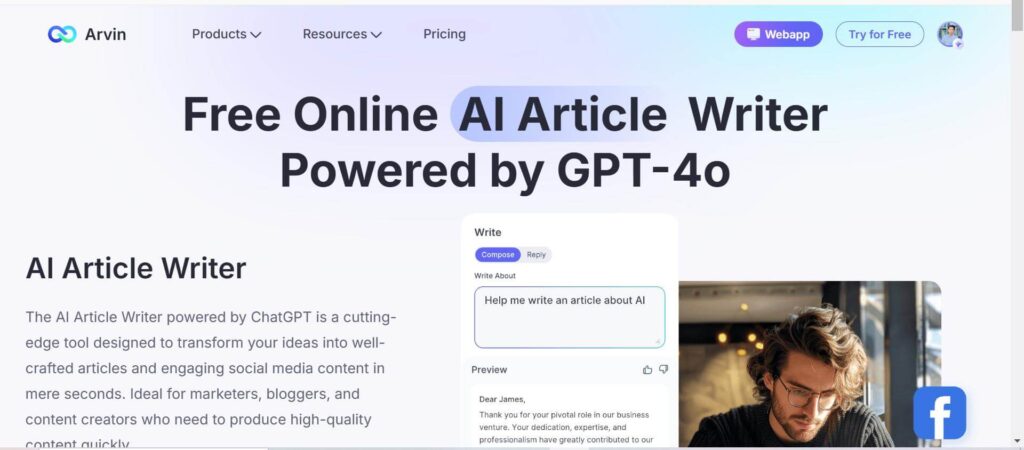
Step 2: Put in basic information regarding the purpose of your statement as well as your goals, background.
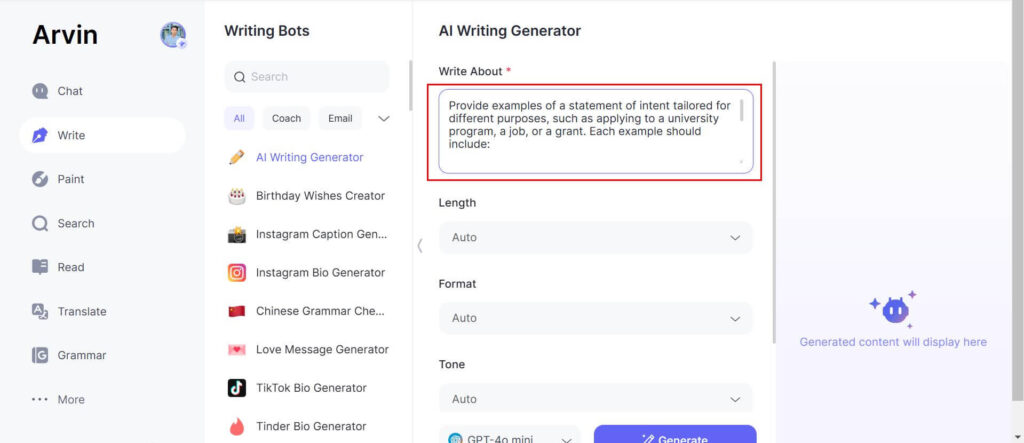
Step 3: Let Arvin AI produce a draft uniquely customized for your inputs.

Step 4: Proofread and finalize your statement using editing tools and instant feedback.
Step 5: Copy and make file of the polished statement in your preferred format, ready for submission.
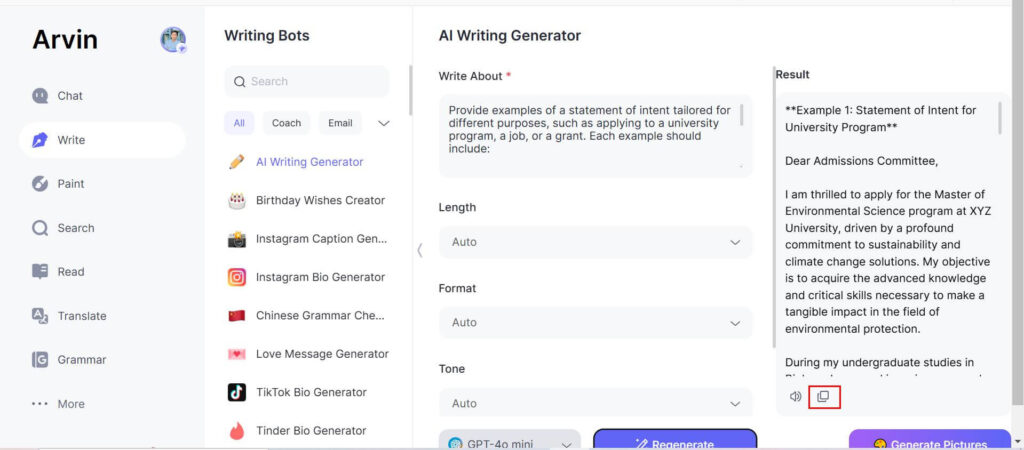
Conclusion
A good statement of intent examples is the key component in any application: it communicates your ambitions, qualifications, and fit in a program. Tools such as Arvin AI bring innovation to the table with efficiency, personalization, and originality. Using Arvin AI will enable you to craft compelling, bespoke statements that speak to your audience. Transform your ideas into impactful statements effortlessly. Check out Arvin AI today and begin creating a statement of intent examples that hits all the right notes, easy!
Part 5: FAQs on Statement of Intent Writing
1. What is the right length for a statement of intent?
Generally, an ideal statement of intent ranges from 500 to 1,000 words in length. Never forget that a specific set of guidelines given by an institution or organization may impose strict limits regarding the word or page requirement. Any length over what is required may affect your statement of intent examples by creating a sense of failure on your part to notice this detail.
2. Can I reuse the same statement for many applications?
It may be tempting to use the same statement for a few applications, but it should not be done. All institutions or programs have distinct values, goals, and expectations. Reusing the same statement without tailoring it might make your application appear generic and decrease chances of standing out.
3. How can I make my statement pop?
To make your statement pop, focus on the following:
- Clarity and Structure: Make sure your ideas are presented logically with clear transitions.
- Specificity: Bring out specific accomplishments, skills, or experiences that reflect your suitability.
- Authenticity: Your personality needs to shine through, making you show enthusiasm and your unique perspective.
- Tailored Content: Explain how the program suits your goals and how you can contribute.
- Clichés, overly formal language, and vague statements should be avoided. A well-crafted narrative with solid examples can make for lasting impressions.
4. Should personal anecdotes be used?
Telling personal anecdotes can be a very effective way to connect with your reader and provide insight into your motivations. Choose anecdotes that relate to your goals and that demonstrate qualities such as resilience, passion, or innovation Avoid using anecdotes that are too emotional or too unrelated to your purpose for applying.
5. In what way does Arvin AI make statements unique?
Arvin AI utilizes advanced natural language processing and machine learning to create customized, unique statements of intent. It analyses user input based on goals, achievements, and program requirements to tailor the content. Plagiarism detection also comes as a built-in feature, ensuring originality and allowing applicants to present their submissions with confidence that they are authentic.
